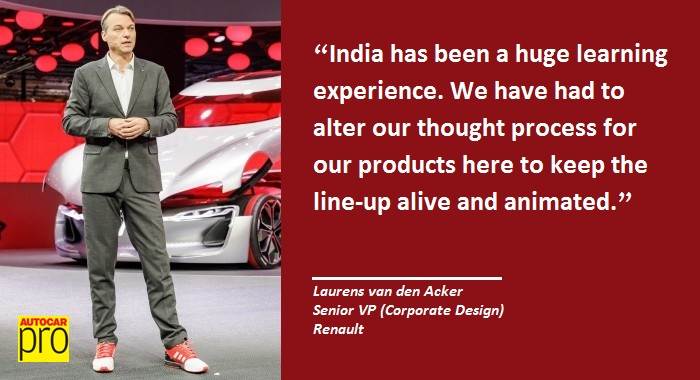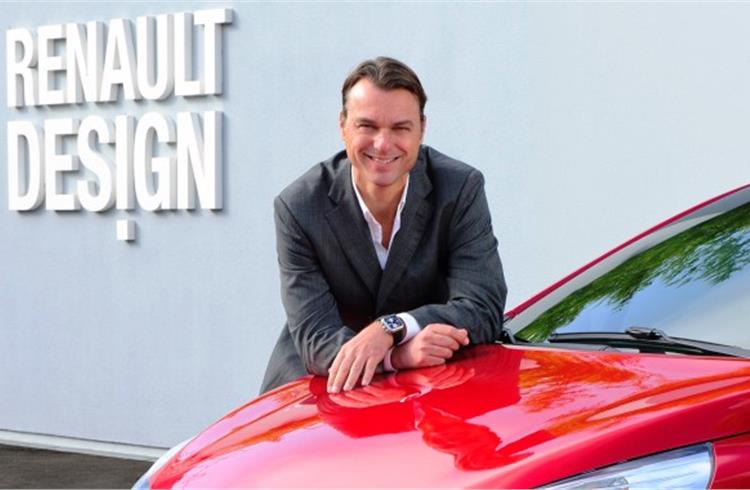'A good car is like meeting an attractive person.'
Laurens van den Acker, Renault's Sr VP for corporate design on his styling philosophy, the challenges that a low-cost car like the Kwid presented, and how budding designers can come up with good design.
Renault’s design strategy is inspired by three keywords that reflect the brand’s vision: simple, sensual and warm. Laurens van den Acker, the French carmaker’s award-winning senior vice-president for corporate design speaks to Hormazd Sorabjee on his styling philosophy, the challenges that a low-cost car like the Kwid presented, and how budding designers can come up with good design.
Renault design is very curvaceous and very organic. How would you describe Renault design, its values and which way is it headed?
Renault design is very sensual. We are a French brand and we are humans and sensual beings who do not have hard lines, which is the reason why our designs are soft and have beautiful highlights. Our designs need to give you a warm feeling and being a popular brand, we need to have cars for all stages of life. So if you fall in love, we have a car for you; if you want to explore, we have our crossovers; if you start a family, we have cars for you too. If you gain wisdom, we have our EVs and the Espace. Thus, we really try to connect our design philosophy with customer requirements to connect with them better.
Renault is very Europe-centric and may not resonate well with customers in South-East Asia or America. Is being a brand that doesn’t necessarily please everyone a challenge?
You will always run into trouble if you say something like, “We are a French brand.” Having said that, I don’t mean that we make cars only for the French people. We have French values and we make very sensual, attractive cars because France as a country seduces its people. You come to France because you love its culture, its food and all the good things in life. Maybe that’s the reason that we make our cars so sensual. We say ‘Renault – Passion for Life’ because that’s the spirit we want to evoke with our cars. This is a very international spirit after all.
The Kwid has been a real success story in India. What were the challenges you faced when designing an ultra-low-cost car like the Kwid?
The biggest challenge with the Kwid was the purchasing power of its customers – it had to fit in that affordable price band but it also had to be aspirational. That was a big contradicting challenge.

The challenge with the Kwid's design was that it had to fit into a tight price-band but it also had to look aspirational.
The big key was the Kwid’s SUV styling because on the totem pole SUVs are considered highly, followed by sedans, and then hatchbacks. We tried very hard to design a micro-car with SUV looks and 13-inch wheels. I’ve never been told to design a car with 13-inch wheels!
Did you have to avoid complex surfaces and use straight ones? What were the trade-offs in terms of design and the real challenges, considering the tight financial constraints?
In terms of complex surfaces, you usually stamp a part 4-5 times to get the shape right before you really focus on the detailing. In the Kwid, there is no part that has been stamped over three times. So, there’s a certain simplicity of shape in all the parts.
The other thing was to keep the pieces as light as possible, and the way to save costs is to remove as many pieces as possible, keep the parts as thin and light. The cheapest parts are those that are not there. So you will find only one wiper, only three bolts in the wheel, and for some of these parts, we are at the absolute limit of what is allowed. But we were so focused on getting a strong basis that these were key in the development of the car.
Is the Kwid one of those cars where you worked very close with engineers and the finance guys, with a lot of communication going back and forth? How do things work when you are building a low-cost car like the Kwid?
Yes, it was vital that the engineering and the product guys worked together. In a normal car, design develops the car, hands it over to the engineers and says, make it. They have three months to negotiate with the suppliers and make it.
With the Kwid, the project team head took it to the suppliers and took a year-and-a-half to negotiate. That’s because if the suppliers had a way to make the car cleverer to cut down costs, we had to return to the design, and this happened many times. We had to do the grille 50 times; while this did not change the design, it helped reduce the cost to what it ended up being.

What is the most challenging part of designing a car? People say that if you have the proportions right, you have a great starting point.
For me, a good car is like meeting an attractive person. From afar, you see the silhouette, you get closer and you see the style, the proportions and the lines of the face. Then you come closer, shake hands, make eye contact and then you embrace.
It’s similar to a car. From a distance, you see the shape, the overhangs, the graphics. Come closer and you see the surfaces and the highlights. You touch it and ensure that every step forward with the car is a positive experience, and this increases the depth of the experience.
A lot of people are looking at seven-seaters and SUVs, where there’s usually a form versus function clash. What is the challenge for the designer, because you need a lot of interior packaging which clashes with the form of the car?
Yes, it happens that the product guy comes to us and says, “I need a car that can seat seven people, fit in 500 litres of luggage, be spacious inside and also look elegant, aerodynamic, and have strong shoulders.”
Sometimes, it’s easier said on paper than making such a car but the Kwid is a good example. It has 300 litres of luggage space, even though the car is reduced and has a lot of space inside.
Sometimes, the challenge is impossible for designers but there are times when we can design a rabbit out of a hat.
Talking about design languages, there are markets which demand shorter lifecycles. How long does design language last? Is it about 10 years or is it two generations of a car? What is the current trend?
You are right about the lifecycles varying from region to region. For instance, in Europe, we are used to a six- to seven-year lifecycle because we come from a 10- to 12-year lifecycle space and we understand that a product needs a certain time to install itself in the market.

India is very different. People want something new every year, and they are very impatient about it. So we have had to alter our thought process for our products here to keep the line-up alive and animated. That has been a huge learning experience.
In India, people like to change their mobile phones every two years. We have this need to connect more, which is likely the reason that we like something new rapidly.
India is also a developing country that, with the internet, has access to a lot more than it has had before. So consumers are hungry. It is a sign of modernity too, and they are looking for the edge to do more and be more than their neighbour, and this pressure is very present in India.
Last, any advice to budding designers? What makes for good car design?
The first thing is to learn how to communicate with your design. My advice to young designers is learning how to draw and express through your design. Because, irrespective of the language you speak, your design is who you are. That is why I find the job of a designer to be the most honest because I’ve found jobs in Italy, Japan and the USA without speaking a word of their language, and only based on my portfolio.
You need to know how to draw. You need the talent of course but, more importantly, you must want to work hard.
RELATED ARTICLES
BRANDED CONTENT: 'We aspire to be among the leading sensors and electro-mechanical products manufacturer'
P. Parthasarathy, Founder & Managing Director, Rotary Electronics Pvt Ltd shares the company's commitment and vision to ...
‘Big opportunity for startups lies in products in India’: Detlev Reicheneder
As electrification levels the playing field, the focus on tech and R&D to bring innovative products is the mantra for st...
'I hope my journey makes people say — I can do this too'
Ranjita Ravi, Co-founder of Orxa Energies — the maker of Mantis e-bikes — shares the challenges of building a startup an...





 18 Nov 2016
18 Nov 2016
 5335 Views
5335 Views





 Autocar Pro News Desk
Autocar Pro News Desk




